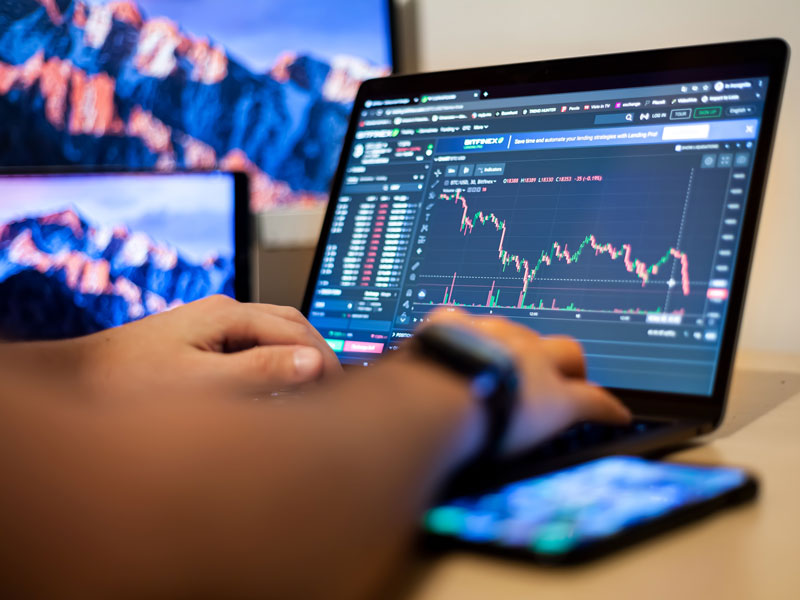Forex trading success is contingent on the management of risk. Here are 10 suggestions for managing risk and protecting your capital.
Set a Stop-Loss or stop-loss order for every trade
1. Stop-loss orders automatically close an order when the market is at a predetermined price, thus limiting possible losses. By placing a Stop-Loss in place, you ensure that your losses are limited if the market moves against you. Set a stop-loss immediately following the opening of an account.
2. Define Risk per Trade
Limit the amount you're willing to risk with every trade. It is generally recommended to limit your risk per trade to 1 to 2 percent. This lets you stay in the market even during losing streaks, and prevents major loss of your account due to a single trade.
3. Use Proper Position Sizing
If you are referring to your the size of your position, this is the amount you pay or trade in a particular currency. The size of your position can be adjusted in accordance with the size of your account, trade risk and the distance between stop-loss and your account. If you have a significant stop-loss, your position will be reduced to keep the risk at the same level.
4. Avoid Over-Leveraging
The use of high leverage can increase the profits and the losses. For beginners, it is best to use low leverage however, brokers often offer higher leverage. As high leverage is a risk to erase your account when your trades go against you, it's better to start with a smaller amount (1:10 or less) and build up the experience.
5. Diversify Your Trades
Do not invest all of your money into a single trading or pair. Diversifying the timeframes and trading pairs helps reduce losses from unexpected market developments. Beware of excessive diversification. It could dilute your focus, and spread you too thin.
6. Implement a trading plan with risk limits
Being disciplined is easy with a trading plan which has clear guidelines for entry, exit and risk tolerance. Set weekly or daily risk limits, such as not putting more than 5percent of your account every day. If you reach your limit, stop to reconsider your strategy instead of continuing to trade out of anger or frustration.
7. Make use of trailing stops to make the most profits
A trailing loss is a stop-loss that is adjustable. It can be adjusted as the trade moves to your advantage. It is possible to make profits in the eventuality of a market correction, while still allowing your trade to grow if it's towards a positive direction. This is a great way to protect profits without having to close the position too soon.
8. Be aware of your emotions and stay clear of revenge-based trading
Emotional trading can lead to inexperienced decision-making and high risk. Fear, frustration and greed may lead to impulsive trading or assuming greater risk than originally planned. If you've suffered a loss, stay clear of "revenge trading" or attempting to recoup losses in a single trade. Follow your plan and minimize risk to avoid escalating losses.
9. Avoid Trading During High-Impact News Events
Events that are highly impactful on markets, such as the announcement of a central bank's decision or economic report, may create extreme volatility. If you are not familiar about news trading, it's better to exit positions or to avoid trading just before and immediately after important announcements. This can cause unexpected losses.
10. Keep a Trading Journal for Reviewing Mistakes
You can gain knowledge from losing and winning trades by keeping a diary. Keep detailed records of each trade. Include the reason why you took the trade, as well as the risks and the place where the stop-loss was placed and what the outcome was. Your journal can provide patterns to show your failures and successes that will allow you to enhance the way you manage risk.
Risk management in Forex trading is just as important as identifying lucrative opportunities. These guidelines will help you to safeguard your capital and control losses. They also help build strategies for trading that are durable. Read the top rated https://th.roboforex.com/ for more recommendations including forexcom, forex broker, united states forex brokers, best broker for currency trading, forex broker, forex trading platform, forex trading trading, broker trading, forex brokers usa, best forex brokers and more.

The Top 10 Tips To Help You Understand And Use Leverage When You Trade Online
Here are the top 10 tips to use leverage in a wise way: 1. Here are ten top tips to help you understand and use leverage effectively:1.
1. Learn the basics of leverage
Leverage lets you control an even larger amount of capital than your actual capital. Leverage, as an example, is a 1:100 ratio that means that each $1 you have can be used to control 100 of market. This implies that any move in the market can impact your account balance through this exact fact. This could result in an increase in both gains and losses.
2. Be aware of the risks associated with high leverage
Gains and losses are amplified by higher leverage. If you leverage 1:500, the risk of a 0.2 percent negative movement in price could erase the entire amount invested. A leverage ratio of 1:500 could erase the entirety of your investment.
3. Start with a low leverage
If you're a newbie to Forex trading, it is ideal to begin with a leverage ratio of 1:10 or 1:20-especially if this is your first time. This will help keep your losses in check and build confidence and experience without putting your capital in danger.
4. Calculate the Margin Required
Every leveraged trade comes with a margin requirement. It is the amount you must maintain in your account prior to opening a new account. For instance, a trade worth $10,000 is, for example, requiring just $100 of margin. To avoid liquidation of positions or margin calls, be sure that you're aware of these rules.
5. Utilize leverage in line with Your Trading Strategy
The short-term, high-frequency trading market might benefit from moderate leverage due to tight stop-loss placements. Long-term positions could be better off with a lower leverage since they are held for longer durations of time. Make sure you use leverage that is suitable for the type of trade and the goals.
6. Set strict stop-loss orders for every trade
Stop-loss options limit the loss of a leveraged trade, and protect your capital in the event the market moves against you. Because leverage can increase losses, always set a stop-loss at a level aligned with your risk tolerance. This can stop losses from spiraling.
7. Monitor Your Leverage Ratio Regularly
You should monitor your position often to ensure you don't unintentionally overleverage. Leverage ratios can be maintained by closing or reducing certain trades.
8. Utilize a margin calculator, or leverage tool
Many brokers offer tools or calculators that calculate the amount of leverage your trade will require and the margin you require. These tools can help you assess the risk you're taking and help you avoid overuse of leverage.
9. Be aware of the restrictions on leverage by Region
Different regions have different leverage caps, based upon regulatory guidelines. For instance in the U.S., retail traders are restricted to a 1:150 leverage ratio, whereas in the EU, leverage on the major currencies is capped at 11:30. Choose a leverage ratio that is within the limit of law to reduce risk and ensure compliance.
10. Re-evaluate the leverage in light of market conditions
Market conditions can quickly change, which affects the risk profile of leveraged trades. In times of volatility or when there is a release that has a high impact on the market, you might want to decrease your leverage. Reducing your leverage in uncertain times can help protect your account from sudden, abrupt price moves.
Summary: Leverage should be used with an knowledge of its benefits as well as the risks. If you are able to use leverage with caution and setting stop-loss protection orders, and choosing an appropriate leverage ratio, you will reap the advantages while minimizing dangers. See the top rated for more examples including best currency trading platform, currency trading demo account, forex market online, best currency trading app, brokers for forex in usa, regulated forex brokers, fbs broker review, best forex brokers, top forex brokers, broker trading and more.

Top 10 Trading Platform And Technology Tips When You Are Thinking About Online Forex Trading
1. Selecting the right trading platform and knowing the technology involved is vital when it comes to Forex trading. Here are 10 strategies to guide you through trading platforms and make use of technology for a better trading experience.
Choose a platform that is user-friendly
Opt for an application that is simple and easy to use. You must be able easily to use charts, monitor trades and make orders. Platforms such as MetaTrader 4 (MT4), MetaTrader 5 (MT5), and TradingView are well-known for their user-friendly interfaces and versatility.
2. Ensure Strong Internet Connectivity
Forex trading requires reliable Internet access. A slow or unstable connection can lead to delayed order execution as well as missed opportunities and slippage. If you are experiencing frequent issues with connectivity, you should upgrade your connection to the Virtual Private Server.
3. Speed of Test Order Execution
Fast order execution is crucial, especially for day traders or scalpers. A platform with fast execution times will reduce slippage. This ensures you are in a position to trade and withdraw trades at the prices you've decided. It is possible to test the platform using a Demo Account before committing your real money.
4. Explore Charting and Analysis Tool
A robust platform should offer advanced charts, indicators, and features for technical analysis. You should look for platforms that have custom charts, the capability to access many indicators, and the ability to perform an in-depth analysis. This will allow you to make better-informed decisions when trading.
5. Check Mobile Trading Capabilities
Mobile trading applications give you the flexibility to monitor your trades and manage them on the go. Verify that the mobile app includes all the features you need such as trades, charting, and account monitoring.
6. Automated Trading Systems
To ensure consistency and lessen the manual work involved, many traders use robots or automated trading strategies. If automation interests you consider a platform that supports expert advisors (EAs) or trading bots. MT4 and MT5 for example are compatible with a wide range of automated trading tools.
7. Verify the security features
Trading online is a risky business. Choose a platform that has encryption protocols (copyright) and two-factor verification (copyright), and additional security features to guard your information and cash. Platforms that do not have strong security measures can expose users to cyber-attacks.
8. Find out about real-time data and News Feeds
In order to make quick decisions, you need to be able to receive real-time alerts about the latest economic developments and market prices. A good trading platform will integrate reliable news feeds, as well as precise market data. This will allow you to be aware of any developments that might impact your trading.
9. Check compatibility with your trading Style
Different platforms suit different trading styles. For instance, platforms with one-click trades and quick execution are ideal for scalpers, and those that have extensive charting and analysis tools are better for swing traders. Make sure the platform you choose is suitable for your needs for trading.
10. Test customer support and platform reliability
It is essential to have a reliable customer service team, especially if you encounter issues regarding your platform or need technical assistance. You can test the expertise of and speed of response of the support staff by contacting them with questions. Also, look over the history of the platform's stability and uptime, as frequent downtimes or crashes could impact the performance of your trading.
By carefully selecting the right trading platform with your needs and understanding the technical aspects of it, it is possible to improve your trading efficiency and remain better prepared to deal with market changes. It is important to prioritize usability and security and the right tools to support your trading. Have a look at the recommended https://th.roboforex.com/beginners/info/national-holidays/ for more examples including app forex trading, trader fx, forex trading, best currency trading platform, broker cfd, app forex trading, forex app trading, best forex trading broker, forex market online, trader fx and more.
